
|
|
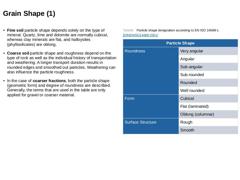
|
-
Fine soil particle shape depends solely on the type of mineral. Quartz, lime and dolomite are normally cubical, whereas clay minerals are flat, and halloysites (phyllosilicates) are oblong.
-
Coarse soil particle shape and roughness depend on the type of rock as well as the individual history of transportation and weathering. A longer transport duration results in rounded edges and smoothed out particles. Weathering can also influence the particle …
|
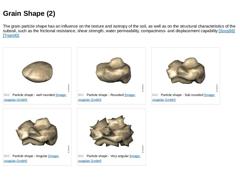
|
The grain particle shape has an influence on the texture and isotropy of the soil, as well as on the structural characteristics of the subsoil, such as the frictional resistance, shear strength, water permeability, compactness- and displacement capability [Soos96] [Trian00]. (Image: Particle shape - well rounded) (Image: Particle shape - Rounded) (Image: Particle shape - Sub rounded) (Image: Particle shape - Angular) (Image: Particle shape - Very … |

|
|
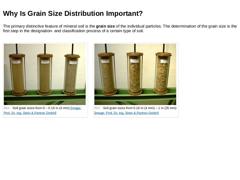
|
The primary distinctive feature of mineral soil is the grain size of the individual particles. The determination of the grain size is the first step in the designation- and classification process of a certain type of soil. (Image: Soil grain sizes from 0 – 4 mm) (Image: Soil grain sizes from 4 – 25 mm) |
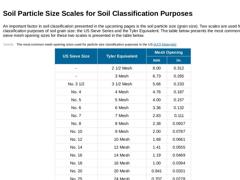
|
An important factor in soil classification presented in the upcoming pages is the soil particle size (grain size). Two scales are used for classification purposes of soil grain size: the US Sieve Series and the Tyler Equivalent. The table below presents the most common sieve mesh opening sizes for these two scales is presented in the table below. (Table: US sieve mesh size) |
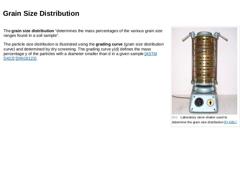
|
|
The grain size distribution “determines the mass percentages of the various grain size ranges found in a soil sample”. The particle size distribution is illustrated using the grading curve (grain size distribution curve) and determined by dry screening. The grading curve y(d) defines the mass percentage y of the particles with a diameter smaller than d in a given sample [[ASTM D422]] [DIN18123]. |
(Image: Laboratory sieve shaker used to determine … |
|
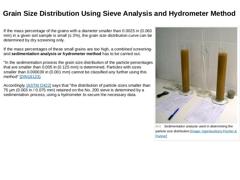
|
|
If the mass percentage of the grains with a diameter smaller than 0.0025 in (0.063 mm) in a given soil sample is small (≤ 3%), the grain size distribution curve can be determined by dry screening only. If the mass percentages of these small grains are too high, a combined screening- and sedimentation analysis or hydrometer method has to be carried out. “In the sedimentation process the grain size distribution of the particle percentages that are smaller … |
|
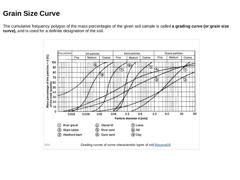
|
The cumulative frequency polygon of the mass percentages of the given soil sample is called a grading curve (or grain size curve), and is used for a definite designation of the soil. (Image: Grading curves of some characteristic types of soil [Neuma64]) |
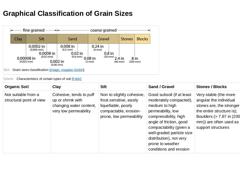
|
(Image: Grain sizes classification) (Table: Soil characteristics) |
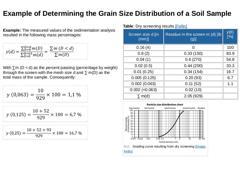
|
Example: The measured values of the sedimentation analysis resulted in the following mass percentages: (Formula: Aus den Messwerten der Siebanalyse folgten die Gewichtsanteile) With ∑m (D < d) as the percent passing (percentage by weight) through the screen with the mesh size d and ∑ m(D) as the total mass of the sample. Consequently: (Formula: Gewichtsanteil y(0,063)) (Formula: Gewichtsanteil y(0,125)) (Formula: Gewichtsanteil y(0,25)) |
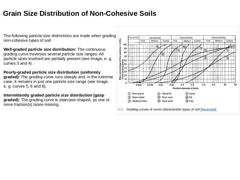
|
|
The following particle size distinctions are made when grading non-cohesive types of soil: Well-graded particle size distribution: The continuous grading curve traverses several particle size ranges. All particle sizes involved are partially present (see Image, e. g. curves 3 and 4). Poorly-graded particle size distribution (uniformly graded): The grading curve runs steeply and, in the extreme case, it remains in just one particle size range (see … |
|
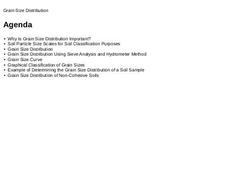
|
|
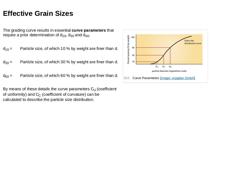
|
The grading curve results in essential curve parameters that require a prior determination of d10, d30 and d60. |
d10 = |
Particle size, of which 10 % by weight are finer than d. |
|
d30 = |
Particle size, of which 30 % by weight are finer than d. |
|
d60 = |
Particle size, of which 60 % by weight are finer than d. |
By means of these details the curve parameters CU (coefficient of uniformity) and CC (coefficient of curvature) can be calculated to describe the … |
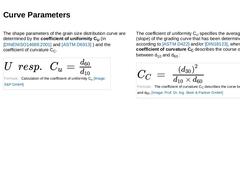
|
The shape parameters of the grain size distribution curve are determined by the coefficient of uniformity CU (in [DINENISO14688:2001] and [[ASTM D6913]] ) and the coefficient of curvature CC. (Formula: Calculation of the coefficient of uniformity CU) The coefficient of uniformity CU specifies the average inclination (slope) of the grading curve that has been determined according to [[ASTM D422]] and/or [DIN18123], whereas the coefficient of curvature … |
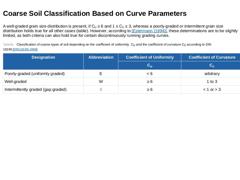
|
A well-graded grain size distribution is present, if CU ≥ 6 and 1 ≤ CC ≤ 3, whereas a poorly-graded or intermittent grain size distribution holds true for all other cases (table). However, according to [Estermann (1994)], these determinations are to be slightly limited, as both criteria can also hold true for certain discontinuously running grading curves. (Table: Classification of coarse types of soil depending on the coefficient of uniformity and … |
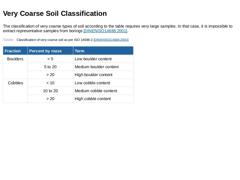
|
The classification of very coarse types of soil according to the table requires very large samples. In that case, it is impossible to extract representative samples from borings [DINENISO14688:2001]. (Table: Classification of very coarse soil as per ISO 14688-2) |
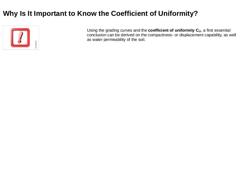
|
Using the grading curves and the coefficient of uniformity CU, a first essential conclusion can be derived on the compactness- or displacement capability, as well as water permeability of the soil. |
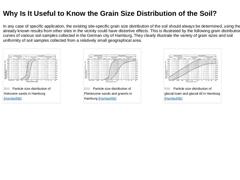
|
In any case of specific application, the existing site-specific grain size distribution of the soil should always be determined, using the already known results from other sites in the vicinity could have distortive effects. This is illustrated by the following grain distribution curves of various soil samples collected in the German city of Hamburg. They clearly illustrate the variety of grain sizes and soil uniformity of soil samples collected … |

|
|

|
The soil condition of coarse types of soil is characterised by the bedding density, whereas fine types of soil are characterised by their consistency.
[[EN ISO 14688:2002]] |

|
|
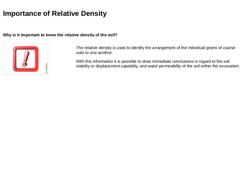
|
Why is it important to know the relative density of the soil? The relative density is used to identify the arrangement of the individual grains of coarse soils to one another. With this information it is possible to draw immediate conclusions in regard to the soil stability or displacement capability, and water permeability of the soil within the excavation. |
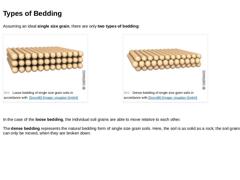
|
Assuming an ideal single size grain, there are only two types of bedding: |
(Image: Loose bedding of single size grain soils in accordance with [Soos96]) |
(Image: Dense bedding of single size grain soils in accordance with [Soos96]) |
In the case of the loose bedding, the individual soil grains are able to move relative to each other. The dense bedding represents the natural bedding form of single size grain soils. Here, the soil is as solid as a rock; … |
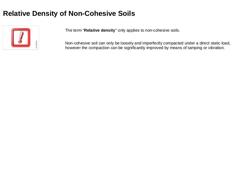
|
The term “Relative density” only applies to non-cohesive soils. Non-cohesive soil can only be loosely and imperfectly compacted under a direct static load, however the compaction can be significantly improved by means of tamping or vibration. |